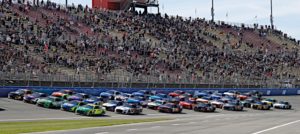By Seth Eggert, Staff Writer
While most drivers, crew members, and race fans are dreading the looming reconfiguration of Auto Club Speedway, not only is the change to the 2.0-mile track warranted, it’s necessary.

The Fontana, Calif. track was last paved when it was built in 1995 and opened in 1997. The track aged like a fine wine, producing better and better racing for NASCAR over time, and it’s come face to face with similar issues as other tracks.
Atlanta Motor Speedway, Daytona International Speedway, Kentucky Speedway, Michigan International Speedway, and Texas Motor Speedway have all been repaved within the past 15 years.
The Speedway Motorsports-owned tracks of Atlanta, Kentucky, and Texas were all reconfigured. Michigan for several years after its repave produced single-file racing. The same happened for Kentucky and Texas with the latter becoming more treacherous for those stepping off the racing line.
While Auto Club Speedway could continue on as a 2.0-mile speedway, its aging asphalt limits the track in several ways. Unfortunately, the mantra of ‘patch and pray’ will not and cannot last forever. Much like a public road riddled with cracks, bumps, and potholes, something has to be done to remedy the situation.
Each of these tracks struggled with weepers after rain storms. The already rain-delayed races suffered further delays by several hours if not to the following Monday or Tuesday.
Atlanta, Daytona, Kentucky, and Michigan also faced the dilemma of potholes. In their final races before their repaves Atlanta and Daytona had lengthy red flags for track repairs.
Michigan’s was minor in comparison. Though the aging and buckling asphalt on the frontstretch formed a sizable bump at the start-finish line.
Looking at Auto Club Speedway, the backstretch has multiple bumps, divots, and jumps from the nearly 30-year-old buckling pavement. It also has suffered from weepers in the turns.
The track has seen a revival in the quality of racing in recent years, both with the NASCAR Cup Series Gen 6 and Next Gen cars, as well as the Xfinity Series cars. However, the various issues from the age of the pavement have taken their toll.
Now, NASCAR and Auto Club Speedway could have simply repaved the track, but the racing likely would have been back to the single-file lanes seen when the track first opened and shortly after the repaves at Kentucky, Michigan, and Texas.
Or, like Speedway Motorsports (SMI) at Atlanta, NASCAR could reconfigure Auto Club Speedway, which is what is ultimately happening. While SMI turned Atlanta into a mini-Superspeedway, NASCAR, based on the most recently announced plans, will turn Auto Club into a short track.
That transformation will take time. As a result, NASCAR will not have a race weekend at Auto Club Speedway in 2024. There is a chance the series won’t race at the track in 2025 either.
“Unfortunately in ‘24, even with the most aggressive plan, we will not race in the new racetrack,” said Auto Club Speedway’s Dave Allen.
The NASCAR fan base has, for years, clamored for more short-track racing. Per reports over the past few years, Auto Club Speedway will be transformed from a two-mile track to a .5-mile track, though further details such as the banking are still to be determined.
Though a recent submission also listed that the reconfigured track would be a .67-mile and not a .5-mile.
Hopefully some clear updates on the Fontana short track will be released this weekend. Everything has been vague in the 900 days since the reconfiguration was announced. Originally, it was a half-mile, but documents submitted to the county last year say it's now 0.67-mile pic.twitter.com/UPALb1L0ET
— nascarman (@nascarman_rr) February 24, 2023
The short track racing that fans have clamored for, is the single-lane bump-and-run style that was a staple for years at Bristol Motor Speedway, Martinsville Speedway, and even the Los Angeles Memorial Coliseum.
So, yes, Auto Club would still be a single-lane track. However, it would be much more akin to the racing that has been seen at Bristol and Martinsville. Moving someone out of the way for position on a short track is less likely to result in a race-ending wreck compared to a similar move on a speedway.
While the on-track product at short-tracks with the Next Gen in 2022 was mixed at best, NASCAR is working on improving the package. At a test at Phoenix Raceway, the sanctioning body used lessons from the Garage 56 program to evaluate potential changes.
Currently, there is no specific timetable for the completion of the planned reconfiguration of the 25-year-old track.